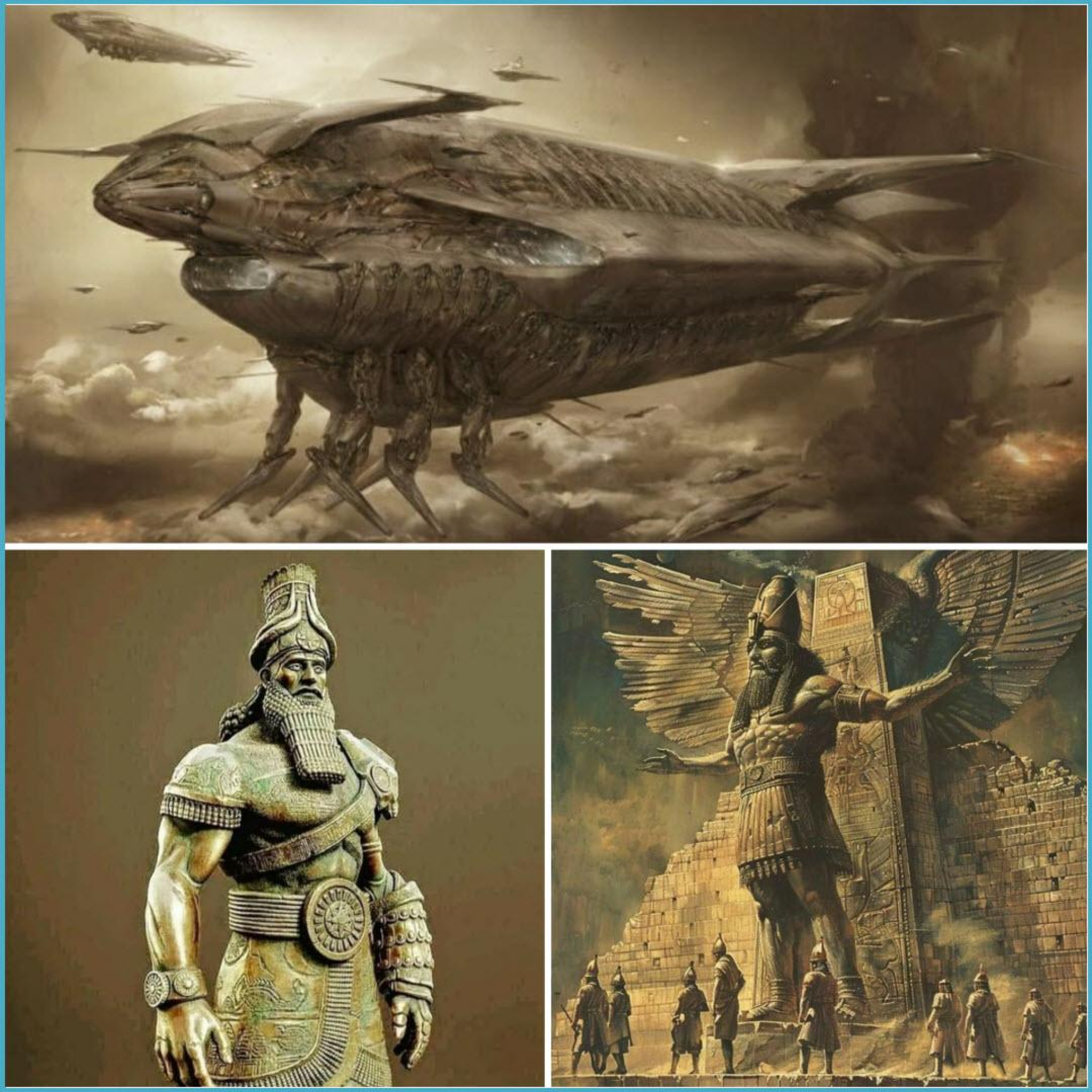
Long before the pyramids crowned the Nile and before Sumerians carved their wedge-shaped script into the clay, there was a tale too old for history books—a memory etched not in stone, but in starlight. It comes not from scrolls or steles, but from the whispered remnants of myth, echoed across civilizations that never knew each other, yet somehow spoke of the same things: gods descending from the sky, wielding power beyond comprehension, shaping cities with fire and precision, and vanishing as suddenly as they came.
This is the story of the Sky Kings.
The Arrival
In the forgotten time before time—before even the fertile plains of Mesopotamia had known kings or gods—the skies were not silent. They roared. Metallic beasts, darker than night and vast beyond reckoning, descended from the clouds in a storm of wind and flame. They did not sail through air like birds, but carved through it like blades, carried by thundering engines and powered by forces modern physics still strains to imagine.
Some called them “Anunnaki.” Others “Watchers,” or “Shining Ones.” The Akkadians, Babylonians, and Sumerians alike depicted them with regal beards, horned helmets, and wings—not for decoration, but as a representation of flight. These were not metaphors. These were memories.
The largest of them was called by a name now lost to human tongues—a craft so colossal it darkened the sky, with legs like fortress pillars and a body that shimmered like obsidian in firelight. From it descended the rulers, clad in armor of gold, faces unreadable behind intricate visors. They were giants in both stature and spirit, and they did not come in peace.
They came to rule.
The First Kingdom
The first city wasn’t built by men—it was imposed by them. The Sky Kings. Using heat so intense it melted stone and tools that cut with perfect precision, they raised ziggurats overnight. Temples dedicated to themselves, towers reaching toward their departing vessels like children reaching for their lost parents.
They appointed overseers. Hybrid beings—part flesh, part machine, part mystery. These figures, immortal in memory and nearly so in lifespan, became the first “gods” of Earth. Enlil, Enki, Ninurta, Inanna—names that would echo through millennia, eventually watered down into deity myths, but once very real. They taught language. Astronomy. Agriculture. But their gifts were never free.
Beneath the surface of Earth, they extracted something precious—not gold, as some have guessed, but something stranger: monoatomic elements, superconductive materials, minerals now barely understood, which powered their skyfaring vessels and extended their dominion across worlds.
And they used us.
The Rise of Rebellion
At first, the humans served willingly, awed by the celestial visitors. Who wouldn’t? They spoke in thunder and carried stars in their hands. But awe curdled into fear, and fear into hatred.
The myths speak of a great rebellion. Not between men and gods—but among the Sky Kings themselves. One faction, led by the warlord Ninurta, believed the Earth was to be ruled with iron and fire. Another, under the guidance of Enki, saw in humanity something more—a spark worth nurturing, not enslaving.
Civil war tore through the sky.
The vessels once worshipped now turned their weapons against each other. The sky turned red for years. Mountains were sundered. Oceans boiled. And then—silence.
The Exile
In the aftermath, the surviving Sky Kings left. Some say they returned to their homeworld, others that they sleep still beneath the ice of Antarctica or the sands of the Sahara, buried in dormant stasis until the stars align once more.
They left behind statues—colossal, winged guardians with serene, unreadable expressions. They left behind codes—star charts carved into temple ceilings, schematics hidden in the ratios of ziggurat steps, and a deep, aching wound in human consciousness: a sense that once, we were not alone.
Most importantly, they left behind their creations—us.
The Memory in the Myths
You see, it is easy to dismiss these stories as legend. Our rational age tells us to read myths as metaphors, to interpret gods as archetypes, and to separate religion from history. But what if the opposite is true?
What if the myths are misunderstood history? What if the gods were kings—not of divine essence, but of advanced technology? What if the winged beings of Mesopotamian bas-reliefs are not symbols, but diagrams? What if the war in heaven was not theological, but political? Not metaphysical, but literal?
What if Genesis’s “Nephilim,” the “mighty men of renown,” were survivors of that conflict—giants not just of strength but of inheritance?
And what if… they never truly left?
Clues in Stone
The evidence is not in writing. It is in design.
Why do so many ancient structures show architectural precision we cannot explain? How do mᴀssive stone blocks, weighing hundreds of tons, fit together without mortar across continents? Why do cultures from Sumer to Mesoamerica all depict beings with wings, long beards, and odd helmets?
Why do the oldest myths begin not with a slow rise of man—but a sudden fall from grace?
Why does it feel… like something was lost?
Because perhaps something was.
The Return
There are some who believe we are nearing the end of the cycle. That the Sky Kings, or whatever they once were, will return. Not with wrath, perhaps, but with reckoning. That the ancient war left unfinished may soon resume, with Earth as its final battleground.
Whether true or not, the images linger.
A fleet of impossible ships cutting through the clouds. тιтans walking among men, their armor gleaming with forgotten runes. Cities built overnight. Languages spoken in light and sound. Knowledge beyond any human era.
The first kingdom. The last war.
Conclusion: In the Shadow of Giants
We walk beneath shadows cast by beings we no longer remember, but somehow still dream about. The figures in the ancient carvings, the winged men with beards like rivers and eyes like burning coals—they weren’t gods.
They were warnings.
And perhaps, echoes of ourselves—of what we once served, or what we might become.
So the next time you gaze upon the ruins of Babylon, or feel your pulse stir at the sight of winged guardians carved in stone, don’t ask who built them.
Ask instead: what were they running from?
And when will it return?


